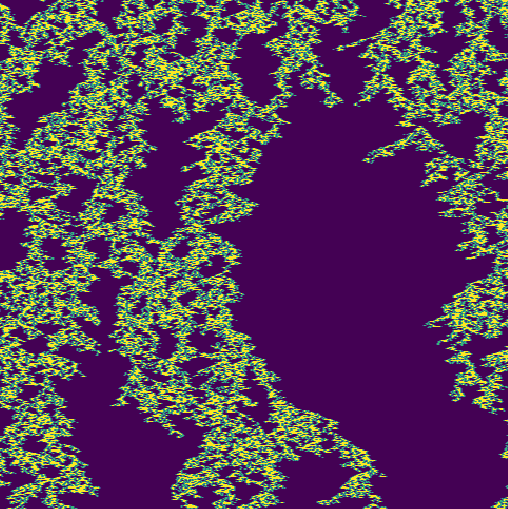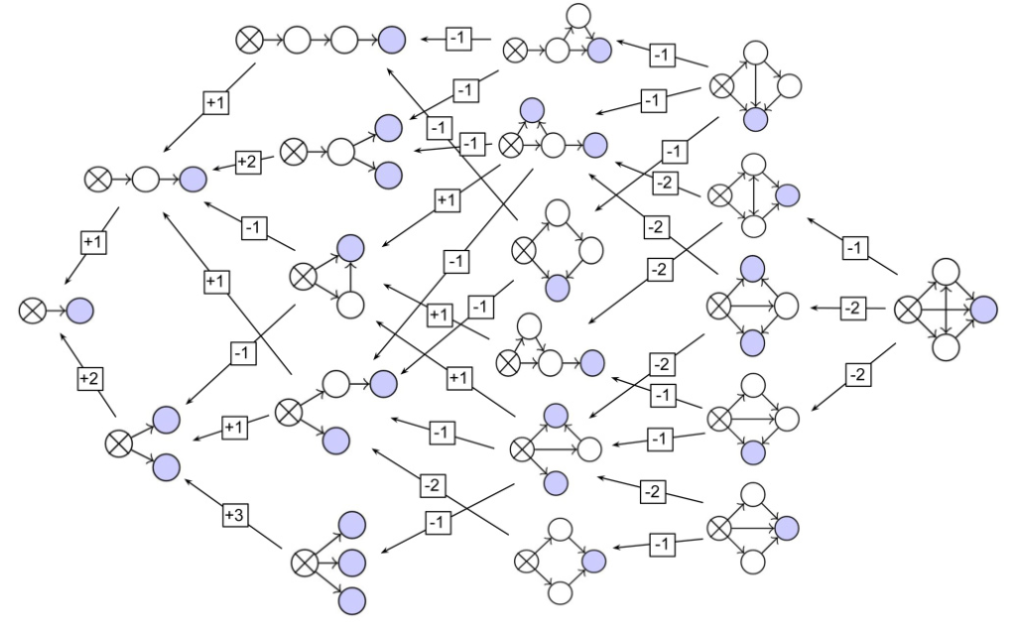My research spans a wide range of topics in theoretical physics of complex systems, including stochastic modeling of out-of-equilibrium systems, information dynamics on networks, and modeling dynamical systems with tensor networks. Below is a list of my current research projects. For a comprehensive list of published papers see Google Scholar. My past research in high-energy physics can be found on InSpire.
Selected research projects
Risk aversion promotes cooperation
with Jay Armas, Janusz Meylahn, Soroush Rafiee Rad, and Mauricio J. del Razo
Cooperative dynamics are central to our understanding of many phenomena in living and complex systems, including the transition to multicellularity, the emergence of eusociality in insect colonies, and the development of full-fledged human societies. However, we lack a universal mechanism to explain the emergence of cooperation across length scales, across species, and scalable to large populations of individuals. We present a novel framework for modelling cooperation games with an arbitrary number of players by combining reaction networks, methods from quantum mechanics applied to stochastic complex systems, game theory and stochastic simulations of molecular reactions. Using this framework, we propose a novel and robust mechanism based on risk aversion that leads to cooperative behavior in population games. Rather than individuals seeking to maximize payouts in the long run, individuals seek to obtain a minimum set of resources with a given level of confidence and in a limited time span. We explicitly show that this mechanism leads to the emergence of new Nash equilibria in a wide range of cooperation games. Our results suggest that risk aversion is a viable mechanism to explain the emergence of cooperation in a variety of contexts and with an arbitrary number of individuals greater than three.
Tensor Networks for Epidemic Modeling
with Philippe Corboz and Clelia de Mulatier
The contact process is an emblematic model of a non-equilibrium system, containing a phase transition between inactive and active dynamical regimes. In the epidemiological context, the model is known as the susceptible-infected-susceptible (SIS) model, and widely used to describe contagious spreading. In this work, we demonstrate how accurate and efficient representations of the full probability distribution over all configurations of the contact process on a one-dimensional chain can be obtained by means of Matrix Product States (MPS). We modify and adapt MPS methods from many-body quantum systems to study the classical distributions of the driven contact process at late times. We give accurate and efficient results for the distribution of large gaps, and illustrate the advantage of our methods over Monte Carlo simulations. Furthermore, we study the large deviation statistics of the dynamical activity, defined as the total number of configuration changes along a trajectory, and investigate quantum-inspired entropic measures, based on the second Rényi entropy.
Emergent information dynamics in many-body interconnected systems
with Manlio de Domenico
The information implicitly represented in the state of physical systems allows for their analysis using analytical techniques from statistical mechanics and information theory. This approach has been successfully applied to complex networks, including biophysical systems such as virus-host protein-protein interactions and whole-brain models in health and disease, drawing inspiration from quantum statistical physics. Here we propose a general mathematical framework for modeling information dynamics on complex networks, where the internal node states are vector valued, allowing each node to carry multiple types of information. This setup is relevant for various biophysical and sociotechnological models of complex systems, ranging from viral dynamics on networks to models of opinion dynamics and social contagion. Instead of focusing on node-node interactions, we shift our attention to the flow of information between network configurations. We uncover fundamental differences between widely used spin models on networks, such as voter and kinetic dynamics, which cannot be detected through classical node-based analysis. We illustrate the mathematical framework further through an exemplary application to epidemic spreading on a low-dimensional network. Our model provides an opportunity to adapt powerful analytical methods from quantum many-body systems to study the interplay between structure and dynamics in interconnected systems.
Exact solutions for SI dynamics on networks
with Ivano Lodato
The susceptible-infected (SI) model is the most basic of all compartmental models used to describe the spreading of information through a population. Despite its apparent simplicity, the analytic solution of this model on networks is still lacking. We address this problem here using a novel formulation inspired by the mathematical treatment of many-body quantum systems. This allows us to organize the time-dependent expectation values for the state of individual nodes in terms of contributions from subgraphs of the network. We compute these contributions systematically and find a set of symmetry relations among subgraphs of differing topologies. We use our novel approach to compute the spreading of information on three different sample networks. The exact solution, which matches with Monte Carlo simulations, visibly departs from the mean-field results.
Past research projects

Asymptotic symmetries of three-dimensional (super)gravity
The study of asymptotic symmetries in three dimensional gravity focuses on the boundary behavior of spacetime, particularly examining the asymptotic symmetries that leave the boundary fields invariant. These symmetries play a pivotal role in the AdS/CFT correspondence, connecting a gravitational theory in AdS space to a dual conformal field theory living on the boundary. The geometric action on the coadjoint orbit of the asymptotic symmetry groups involves the symplectic structure associated with these symmetries. This approach allows for a geometric interpretation of the symmetries’ action, revealing a connection between the bulk gravitational theory and the boundary conformal field theory. This work provides insights into the relationship between the bulk and boundary theories, shedding light on fundamental aspects of quantum gravity and offering a deeper understanding of holography in the context of the AdS/CFT correspondence.
Publications related to this research project:
- Asymptotic dynamics of AdS3 gravity with two asymptotic regions, with Marc Henneaux, and Arash Ranjbar
- Geometric actions and flat space holography, with Max Riegler
- Asymptotic dynamics of three dimensional supergravity and higher spin gravity revisited, with Arash Ranjbar and Turmoli Neogi
Soft hairy black holes and near-horizon symmetry algebra
Research into black holes with soft hair focuses on understanding the near-horizon symmetries and their implications for the information loss paradox. Soft hair refers to a set of zero-energy excitations near the event horizon of black holes, which contribute to the black hole’s entropy and potentially resolve the information loss puzzle. Investigating the near horizon symmetry algebras, particularly the symmetries associated with the dynamics near the black hole’s horizon, offers a new perspective on black hole microstates and information storage. The soft hair paradigm suggests that these symmetries might encode information that would otherwise be lost due to Hawking radiation, potentially offering a resolution to the information loss paradox in black hole physics. Understanding these symmetries and their relation to the quantum structure of black holes is a promising avenue in reconciling quantum mechanics with general relativity and elucidating the fate of information that falls into black holes.
Publications related to this project:
- Soft Heisenberg hair on black holes in three dimensions with Hamid Afshar, Stephane Detournay, Daniel Grumiller, Alfredo Perez, David Tempo and Ricardo Troncoso
- Soft hairy horizons in three spacetime dimensions with Hamid Afshar, Daniel Grumiller, Alfredo Perez, David Tempo and Ricardo Troncoso
- Near horizon dynamics of three dimensional black holes with Daniel Grumiller
- Soft hairy warped black hole entropy with Philip Hacker and Daniel Grumiller


Three dimensional massive gravity and Chern-Simons-like theories of gravity
Massive gravity theories introduce massive gravitons while preserving consistent linearized dynamics of gravity, with potential implications for dark energy and dark matter. In three spacetime dimensions, adding consistent combinations of higher-derivative terms to the Einstein-Hilbert action also gives rise to a massive graviton. However, the boundary theory of positive energy bulk gravitons has negative central charge, leading to loss of unitary. We propose a generalization in a first-order formulation, leading to a set of ‘Chern-Simons-like theories of gravity’ positive bulk energy and positive boundary central charge can be achieved simultaneously. The parity-preserving generalization related to bimetric theories of gravity, while the parity-odd generalization gives an alternative to topologically massive gravity
Publications related to this research project:
- Minimal Massive 3D Gravity, with Eric Bergshoeff, Alasdair Routh and Paul Townsend
- Zwei-Dreibein Gravity: A Two-Frame-Field Model of 3D Massive Gravity, with Eric Bergshoeff, Sjoerd de Haan, Olaf Hohm and Paul Townsend
- Chern-Simons-like Gravity Theories, with Eric Bergshoeff, Olaf Hohm and Paul Townsend
- Extended massive gravity in three dimensions and Interacting spin-2 fields in three dimensions with Eric Bergshoeff and Hamid Afshar




